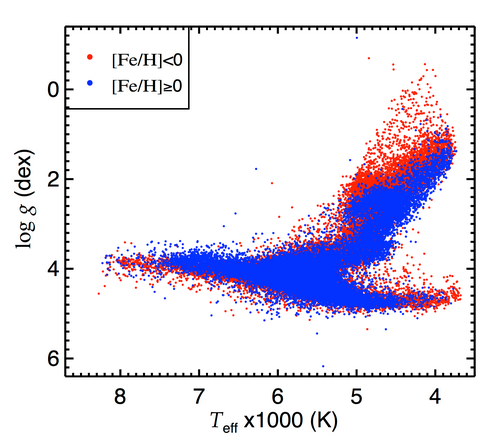The low-resolution spectroscopic observations of the stars in the Kepler field with LAMOST (LK-project) were started on May 30, 2011, at Xinglong observatory. All 14 subfields of the Kepler field had been observed at least once with LAMOST during the 2012-2014 observation seasons (Fig1). 88,628 spectra were obtained with the signal-to-noise ratio in g band (S/Ng) 6.
6.
By adopting the LAMOST Stellar Parameter pipeline (LASP), we have determined the atmospheric parameters (Teff, logg, and [Fe/H]) and heliocentric radial velocityvrad for 51,406 stars with 61,226 spectra. Compared with the atmospheric parameters derived from both high-resolution spectroscopy and asteroseismology for common stars in Huber et al. (2014), an external calibration of LASP atmospheric parameters was made, leading to determination of the external errors for giants and dwarfs, respectively. Multiple spectroscopic observations of the same objects in the Kepler field with LAMOST were used to estimate the internal uncertainties of the atmospheric parameters as a function of S/Ng with the unbiased estimation method. The LASP atmospheric parameters were calibrated based on both the external and internal uncertainties for the giants and dwarfs.
Figure 2 shows the Kiel diagram. A general statistical analysis of the stellar parameters leads to the discovery of 106 candidate metal-poor stars, 9 candidate very metal-poor stars, and 18 candidate high-velocity stars. Fitting formulae were obtained segmentally for both the calibrated atmospheric parameters of the LK-project and the Kepler Input Catalog (KIC) parameters with common stars. The calibrated atmospheric parameters and radial velocities of the LK-project will be useful for studying stars in the Kepler field.
This work has been published in APJS(2016).

Fig1. Spatial distribution of all targets observed during the 2012–2014 observation seasons of the LK-project.

Fig2. Position of the analyzed targets in a Kiel diagram (log gvs. Teff) based on the calibrated stellar atmospheric parameters.













